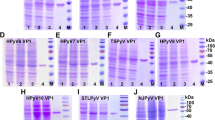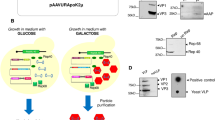Abstract
The effect of codon optimization of L1 gene on the production of the L1 protein of human papillomavirus (HPV) was investigated in a yeast expression system. Saccharomyces cerevisiae was transformed with a plasmid containing either the wild type (WS)-HPV type 58 L1 (HPV58 L1) gene or a codon-optimized (MO)-HPV58 L1 gene. The proportion of soluble L1 protein expressed from MO-HPV58 L1 was significantly higher than that expressed from WS-HPV58 L1. Moreover, the amount of purified MO-HPV58 L1 protein recovered was 2.5-fold higher than the amount of WS-HPV58 L1 protein. Codon optimization of HPV58 L1 gene thus increases the proportion of soluble L1 protein and the amount of purified product that can be used as antigen to generate vaccines.






Similar content being viewed by others
Explore related subjects
Discover the latest articles and news from researchers in related subjects, suggested using machine learning.References
Angov E (2011) Codon usage: nature’s roadmap to expression and folding of proteins. Biotechnol J 6:650–659
Bulmer M (1987) Coevolution of codon usage and transfer RNA abundance. Nature 325:728–730
Conway MJ, Meyers C (2009) Replication and assembly of human papillomaviruses. J Dent Res 88:307–317
Cook JC, Joyce JG, George HA, Schultz LD, Hurni WM, Jansen KU, Hepler RW, Ip C, Lowe RS, Keller PM, Lehman ED (1999) Purification of virus-like particles of recombinant human papillomavirus type 11 major capsid protein L1 from Saccharomyces cerevisiae. Protein Expr Purif 17:477–484
Feige MJ, Hendershot LM (2011) Disulfide bonds in ER protein folding and homeostasis. Curr Opin Cell Biol 23:167–175
Garland SM, Smith JS (2010) Human papillomavirus vaccines: current status and future prospects. Drugs 70:1079–1098
Hulsmeier AJ, Welti M, Hennet T (2011) Glycoprotein maturation and the UPR. Methods Enzymol 491:163–182
Ikemura T (1985) Codon usage and tRNA content in unicellular and multicellular organisms. Mol Biol Evol 2:13–34
Kim HJ, Kim SY, Lim SJ, Kim JY, Lee SJ, Kim H-J (2010) One-step chromatographic purification of human papillomavirus type 16 L1 protein from Saccharomyces cerevisiae. Protein Expr Purif 70:68–74
Kim HJ, Kwag HL, Jin Y, Kim H-J (2011a) The composition of the carbon source and the time of cell harvest are critical determinants of the final yield of human papillomavirus type 16 L1 protein produced in Saccharomyces cerevisiae. Protein Expr Purif 80:52–60
Kim SY, Kim HJ, Kim H-J (2011b) Simple and convenient chromatography-based methods for purifying the pseudovirus of human papillomavirus type 58. Protein Expr Purif 76:103–108
Kim HJ, Lim SJ, Kwag HL, Kim H-J (2012) The choice of resin-bound ligand affects the structure and immunogenicity of column-purified human papillomavirus type 16 virus-like particles. PLoS ONE 7:e35893
Kirnbauer R, Taub J, Greenstone H, Roden R, Durst M, Gissmann L, Lowy DR, Schiller JT (1993) Efficient self-assembly of human papillomavirus type 16 L1 and L1–L2 into virus-like particles. J Virol 67:6929–6936
Kozak M (2005) Regulation of translation via mRNA structure in prokaryotes and eukaryotes. Gene 361:13–37
Kudla G, Murray AW, Tollervey D, Plotkin JB (2009) Coding-sequence determinants of gene expression in Escherichia coli. Science 324:255–258
Laemmli UK (1970) Cleavage of structural proteins during the assembly of the head of bacteriophage T4. Nature 227:680–685
Lajoie P, Moir RD, Willis IM, Snapp EL (2011) Kar2p availability defines distinct forms of endoplasmic reticulum stress in living cells. Mol Biol Cell 23:955–964
Lindl KA, Akay C, Wang Y, White MG, Jordan-Sciutto KL (2007) Expression of the endoplasmic reticulum stress response marker, BiP, in the central nervous system of HIV-positive individuals. Neuropathol Appl Neurobiol 33:658–669
Matsukura T, Sugase M (1990) Molecular cloning of a novel human papillomarvirus (type 58) from an invasive cervical carcinoma. Virology 177:833–836
Mattanovich D, Gasser B, Hohenblum H, Sauer M (2004) Stress in recombinant protein producing yeasts. J Biotechnol 113:121–135
Park MA, Kim HJ, Kim H-J (2008) Optimum conditions for production and purification of human papillomavirus type 16 L1 protein from Saccharomyces cerevisiae. Protein Expr Purif 59:175–181
Pastrana DV, Buck CB, Pang YY, Thompson CD, Castle PE, FitzGerald PC, Kruger Kjaer S, Lowy DR, Schiller JT (2004) Reactivity of human sera in a sensitive, high-throughput pseudovirus-based papillomavirus neutralization assay for HPV16 and HPV18. Virology 321:205–216
Ron D, Walter P (2007) Signal integration in the endoplasmic reticulum unfolded protein response. Nat Rev Mol Cell Biol 8:519–529
Soni R, Carmichael JP, Murray JA (1993) Parameters affecting lithium acetate-mediated transformation of Saccharomyces cerevisiae and development of a rapid and simplified procedure. Curr Genet 24:455–459
Webb E, Cox J, Edwards S (2005) Cervical cancer-causing human papillomaviruses have an alternative initiation site for the L1 protein. Virus Genes 30:31–35
Zhou J, Sun XY, Stenzel DJ, Frazer IH (1991) Expression of vaccinia recombinant HPV 16 L1 and L2 ORF proteins in epithelial cells is sufficient for assembly of HPV virion-like particles. Virology 185:251–257
Author information
Authors and Affiliations
Corresponding author
Electronic supplementary material
Below is the link to the electronic supplementary material.
Rights and permissions
About this article
Cite this article
Kim, H.J., Kwag, HL. & Kim, HJ. Codon optimization of the human papillomavirus type 58 L1 gene enhances the expression of soluble L1 protein in Saccharomyces cerevisiae . Biotechnol Lett 35, 413–421 (2013). https://doi.org/10.1007/s10529-012-1097-y
Received:
Accepted:
Published:
Issue Date:
DOI: https://doi.org/10.1007/s10529-012-1097-y




